6 Tips for a Successful Procurement Audit


Nobody likes audits:
They dissect everything you do, uncovering weaknesses and issues, all while consuming too much of your valuable time.
But what if we told you there’s a way to breeze through audits, both internal and external, without breaking a sweat?
Don’t believe it’s possible?
Well, we’re about to change your mind.
By the time you finish reading this article, you’ll be equipped with six game-changing tips to conquer audits like a pro.
We’ll also sprinkle in some examples and statistics to keep things interesting and guide you toward a procurement process auditing that’s on a whole another level.
Let’s dive in.
Prior to running an audit, it’s absolutely necessary to thoroughly evaluate your procurement function as a whole, identify major challenges and risks, as well as assess their severity.
Spotting weaknesses in your processes early on will prevent these potential risks from snowballing into significant problems.
This, in turn, will facilitate smooth operations within procurement and ultimately ensure favorable audit outcomes in the future.
Let’s face it, any sort of glitch in the system, from poor supplier performance to inefficient data management, can throw you off track, significantly impacting efficiency and even damaging the company’s success and reputation.
For instance, at Quandary Consulting Group, a Denver-based team of IT and Technology consultants, they caution against manual data entry processes within the procurement function.
Why?
Due to the diverse risks they pose, ranging from fraud and human error to poor visibility into procurement activities.
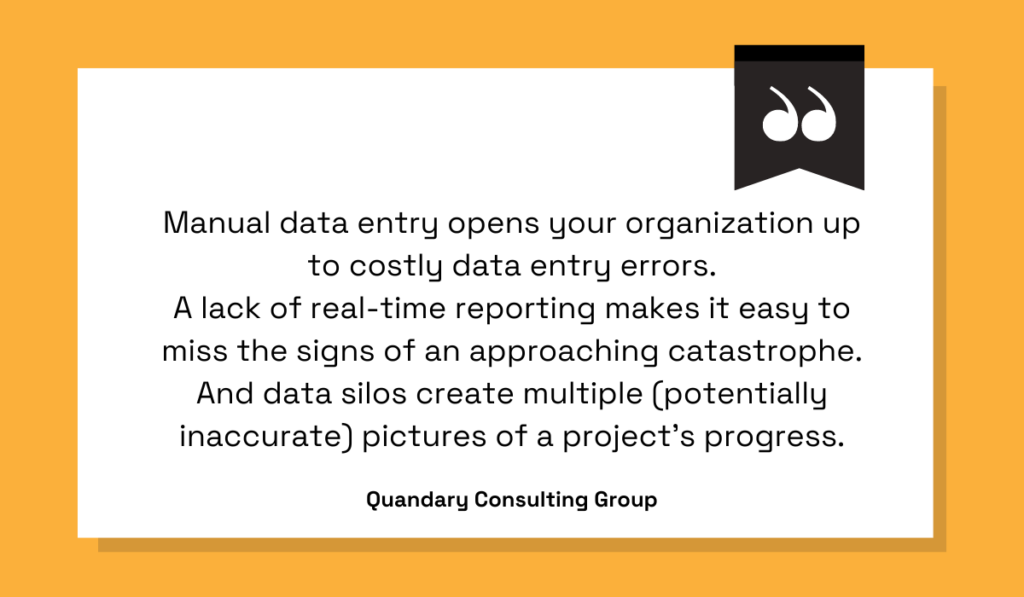
Illustration: Veridion / Quote: Procurement Magazine
The purpose of internal audits, specifically risk assessments, is to detect such inefficiencies before they start causing you substantial harm.
Now, you’re going to want to approach this task holistically, focusing on vital elements such as:
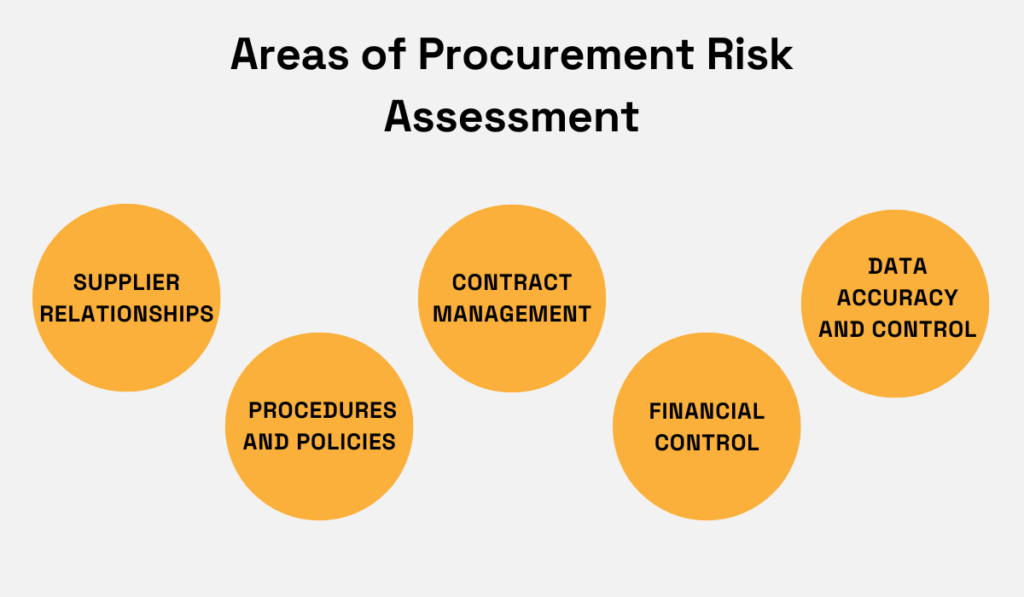
Source: Veridion
Undoubtedly, issues may surface within each of these categories, but try not to panic and attempt to address every identified risk simultaneously.
The trick here is to play smart.
During this phase, you won’t be only identifying risks but also analyzing and prioritizing them based on severity and likelihood of impact.
This will tell you which problems require immediate attention and which ones can be put on the back burner for the time being.
Then, to ensure everyone involved is aware of possible threats and understands how they are being managed, creating a risk register summarizing all findings is a must.
This document should include:
This will be a basis for developing risk management plans and strategies, enabling discussions among project teams and stakeholders about how each risk will be mitigated, transferred, avoided, or—that’s right—accepted.
Overall, risk assessment is a crucial process in the context of procurement audits, so don’t skip it.
It ensures your procurement process is resilient, agile, and compliant with all the regulations, as well as empowers you and your team to tackle any challenge that comes your way.
One of the biggest challenges of procurement audits is the vast volumes of data scattered across different systems, formats, and sources, making the actual process of consolidating and analyzing the information significantly more complicated and time-consuming.
Luckily, this challenge can now be nipped in the bud, thanks to automated data analytics tools and software.
They are invaluable for internal and external auditors alike, empowering them to effortlessly sift through extensive data sets and extract valuable insights in mere moments.
According to Timothy McClung, a freelance web developer, the advent of automated data analytics has rendered manual audits nearly obsolete.
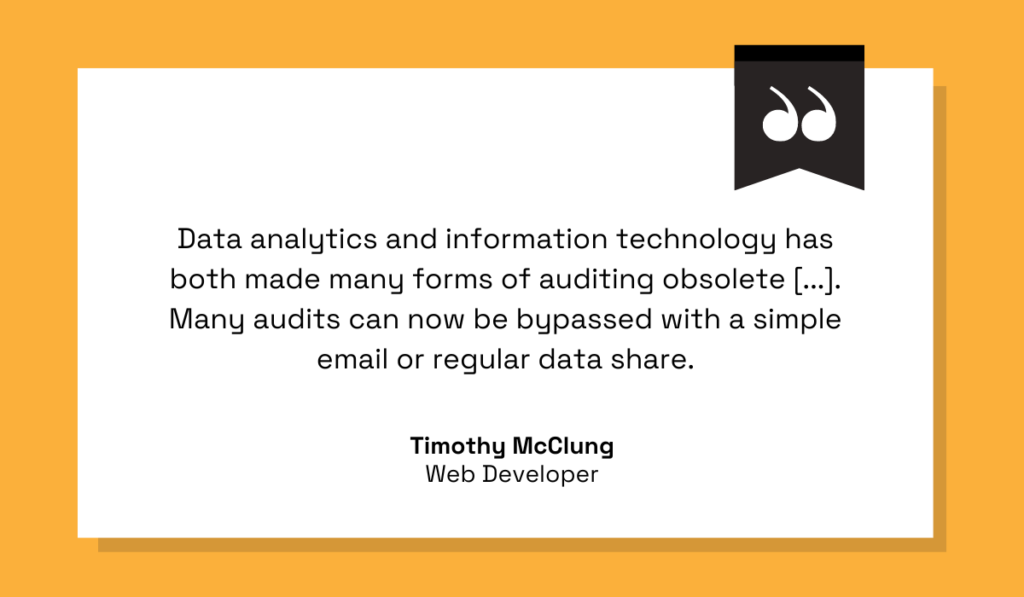
Illustration: Veridion / Quote: Quality Magazine
They allow auditors to identify patterns, trends, anomalies, and areas for improvement much more quickly and with greater accuracy and precision than ever before.
Talk about efficiency.
For instance, Robbie Thompson, executive director at EY, a global leader in assurance, consulting, strategy, transactions, and services, highlights how data analysis helped them spot cost-saving opportunities within the procurement function for one of their clients:
“This project demonstrated how managing supply chain spend appropriately—based on accurate data—can save significant dollars, reduce expensive downtime in the field and limit the amount of capital tied up in unused inventory. We found substantial savings where they’d not historically looked—allowing for strategic deployment of capital elsewhere in the organization. It also showed how the company could improve lead times on key purchases and enhance spending and purchasing forecasts.”
These insights, he says, would have otherwise definitely gone unnoticed.
So, to harness such benefits for yourself and your auditing process, consider exploring software solutions equipped with robust data analytics capabilities.
Because guess what?
They can analyze almost every aspect of procurement.
Spend analysis tools, for example, scrutinize spending patterns and pinpoint areas of waste or potential savings.
Purchase order analytics assess PO coverage, maverick spend, and PO cycle times within seconds.
Supplier discovery platforms like our Veridion analyze supplier performance, confidence scores, and risk factors, enabling proactive identification and mitigation of supplier risks.
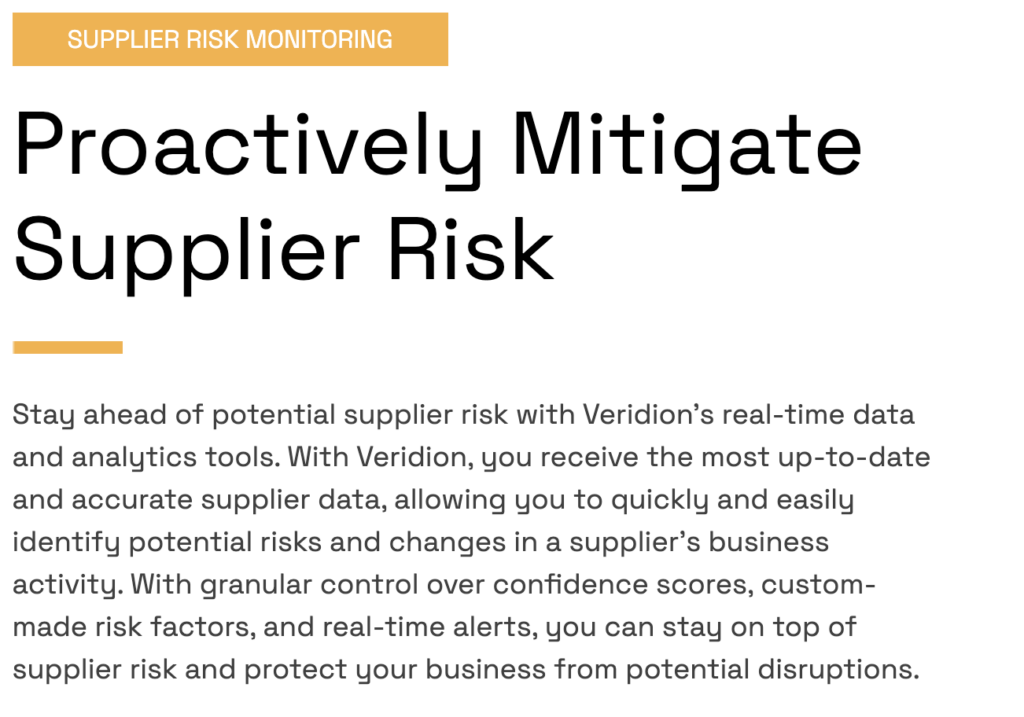
Source: Veridion
Moreover, Veridion can even issue alerts if certain suppliers pose heightened risks, allowing you to act on time and ensure uninterrupted operations.
After all, at Veridion, we understand that timely insight is the golden ticket to success.
At the end of the day, accurate, up-to-date, thorough data is what makes successful audits possible.
But to actually make sense of the information and to effectively derive actionable insights from it, you’re going to need a bit of help.
That’s where analytics tools come into play, infusing your data processing with precision, time savings, and efficiency.
To boost the efficiency of your audits even further, look into establishing a centralized documentation repository.
Why is that so important?
Well, should you choose to skip this step, you might soon find out that it isn’t enough to simply compile and analyze procurement data.
It’s equally important to ensure it’s easily accessible and readily available.
After all, procurement relies on a multitude of document types, including:
Searching for and sifting through all of these during audits can significantly impede the process and make it more labor-intensive.
And let’s not get started on how poor documentation management increases the risk of losing vital records and procurement data.
That’s precisely why it’s so crucial to organize all your files in a way that’s logical and easy to understand for everyone who’s going to be using them.
We recommend actually ditching paper altogether and digitizing your records.
Going digital will ensure ease of access, facilitate version control, and even minimize duplication and data loss.
In other words, it’ll make sure your files are more reliable and ready whenever and wherever you need them.
Did you know that, according to a survey by Forrester and Adobe, 55% of businesses cite accelerated documentation processing as the primary benefit of digital document processes and tools?
Not only that, but an additional 45% note increased employee productivity and time savings as a result of digitization.
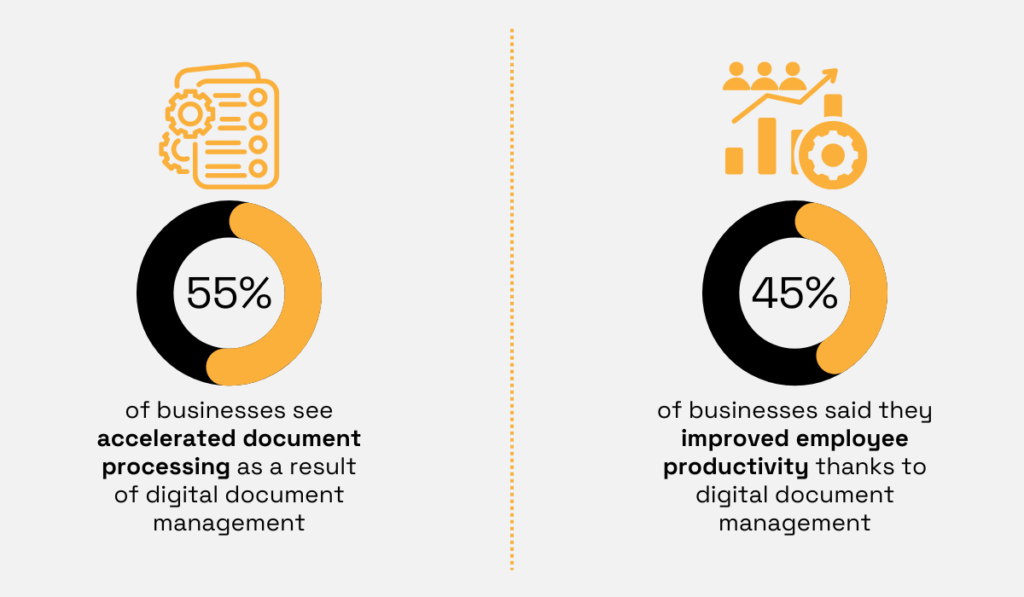
Illustration: Veridion / Data: Adobe
That’s the power of going paperless.
Ultimately, whether you decide to stick to good old paper or embrace digital solutions, the priority remains the same: ensuring documents are meticulously organized, complete, accurate, and easily retrievable.
That way, you guarantee full transparency, allowing auditors to trace the entire procurement process from initiation to completion, hassle-free.
Procurement audits extend beyond the confines of the procurement department itself, permeating various other teams within a company, such as IT, finance, legal, operations, and others.
It’s important to foster collaboration with these teams to ensure a seamless, more efficient auditing process and to shed light on some areas that may be overlooked if relying solely on your procurement team.
For instance, you need:
But, what’s the key to successful collaboration with all these departments?
That’s right—clear, timely, collaborative communication.
It’s essential to inform everyone on time about how the audit will impact their day-to-day tasks, outline their responsibilities, and clarify the type of information they might need to provide during the process.
This will guarantee everybody is well-prepared when the audit time rolls around.
Research conducted by Grammarly offers deeper insight into the significance of effective business communication, revealing that inadequate communication leads to diminished productivity, missed deadlines, prolonged time to resolution, and even increased costs.
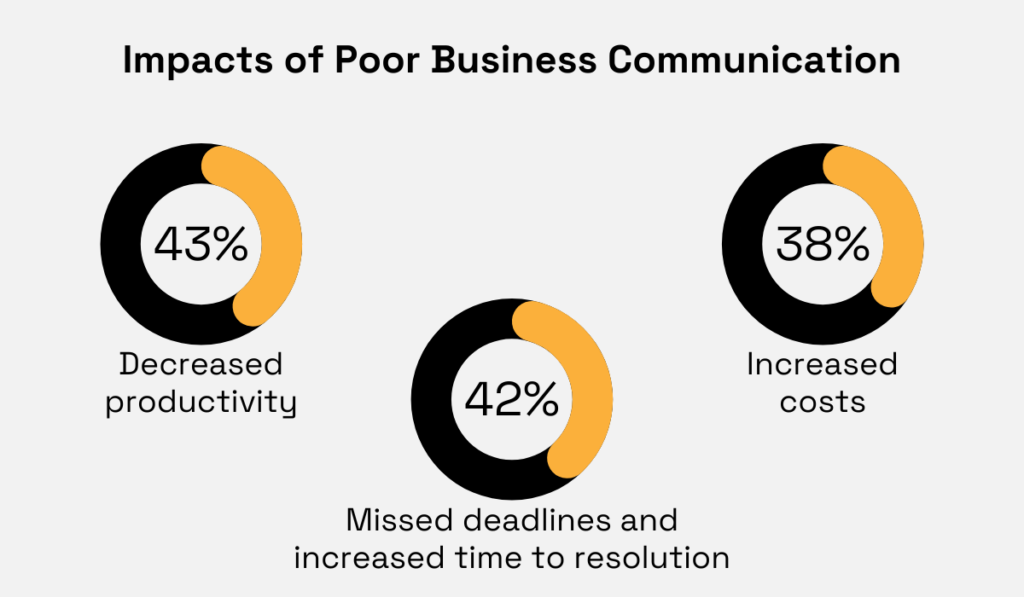
Illustration: Veridion / Data: Grammarly
In other words, the effectiveness and timely completion of your audit might hinge on how well you collaborate with your colleagues more than you’d expect.
Therefore, despite seeming like extra work, it’s vital to hold frequent meetings with coworkers from other departments.
Michael Harris, procurement consultant at BlueCross BlueShield of Tennessee, also advocates for this approach:
“Prior to Covid, our Procurement team members would have a dedicated cube or office space in each business unit’s area. One day each week we would go work in their area, taking time to talk to each member of the business team and the leadership. Post Covid, if you’re working remotely, then set up regularly scheduled check-ins with the business unit’s leadership and discuss strategy on upcoming projects, roadblocks you may be experiencing, etc.“
According to him, procurement should always be on the lookout for opportunities to meet with different teams within a company, gain insights into their operations, and ultimately, build trust.
All in all, collaboration and communication, especially cross-departmental ones, are unfortunately often neglected when it comes to procurement audits.
Nonetheless, they are still crucial for collectively pursuing organizational objectives, adhering to standards, and ensuring informed and smooth audits, free of any complications.
So make sure to not skip this step.
The auditing team’s responsibility doesn’t end with the completion of the auditing process itself, though.
Upon audit completion, it is time to evaluate its success and impact on organizational objectives.
To achieve this, you need to define relevant Key Performance Indicators (KPIs) for auditing efficiency.
After all, you can’t improve what you don’t measure, right?
But, which KPIs should you choose?
That will depend on your specific needs, circumstances, and goals.
However, here are some common ones to get you started:
| Audit Completion Rate | the percentage of scheduled procurement audits completed within the planned timeframe |
| Findings Identification Rate | the number of audit findings or discrepancies identified during procurement audits |
| Severity of Findings | audit findings based on their severity level (e.g., critical, major, minor) |
| Timeliness of Findings Resolution | the average time taken to address and resolve audit findings identified during procurement audits |
| Repeat Findings Rate | the recurrence of audit findings over time |
| Cost Savings and Cost Recovery | the financial impact of procurement audits, including cost savings achieved through process improvements |
Tracking this comprehensive list of metrics will enable you to gauge the efficacy of your procurement audits with pinpoint precision.
Now, regardless of which metrics you decide to monitor, there’s one rule they should all adhere to: they need to be SMART.
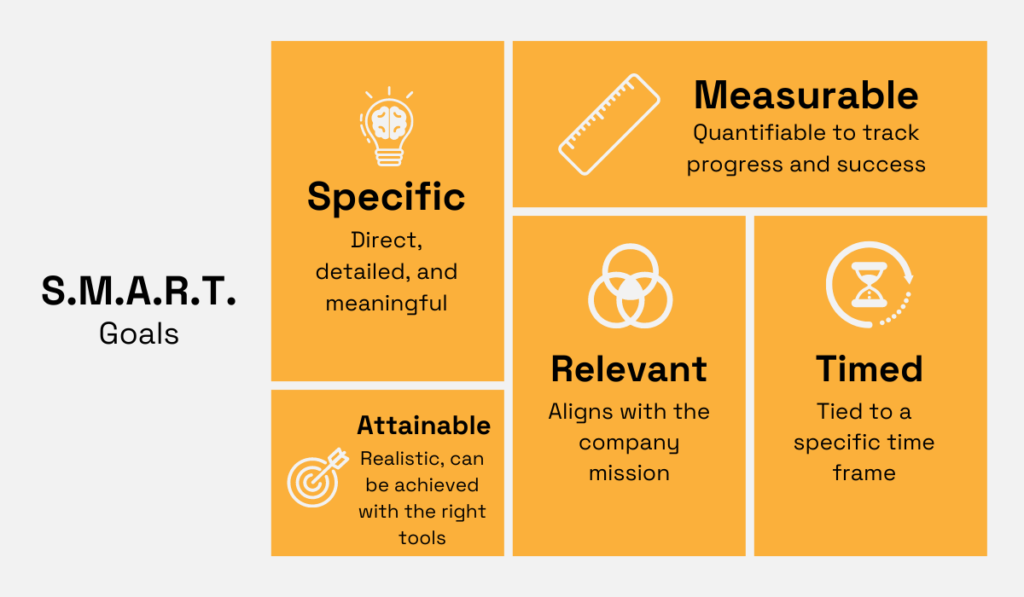
Source: Veridion
Adhering to the SMART framework will give you some clarity when defining your KPIs, ensuring you focus on what truly matters and what is actually achievable.
Still unsure of how it works?
Let’s apply the SMART framework to one of the mentioned KPIs—timeliness of findings resolution—to demonstrate how it all fits together.
| SPECIFIC | This metric specifies what is being monitored clearly: how quickly audit findings are resolved. |
| MEASURABLE | This metric is measurable using time units such as days, weeks, months, etc. |
| ATTAINABLE | This metric is achievable if the organization allocates appropriate resources and establishes efficient processes for tracking audit findings within the specified timeframe. |
| RELEVANT | This metric is relevant because it contributes to the effectiveness of procurement audits and helps in maintaining compliance with regulations and policies. |
| TIME-BOUND | This metric is time-bound because it measures findings resolution over a certain period of time. |
Once you define your own SMART KPIs list, you’ll be well on your way to improving your audits and, consequently, your procurement process as well.
So keep monitoring, measuring, analyzing, and, ultimately, improving.
It may seem like a lot of work now, but it’s well worth the effort when you look at the bigger picture.
Organizational requirements, procurement-related rules and regulations, as well as industry standards, are constantly evolving.
Therefore, to ensure successful audits, it’s paramount to keep pace and regularly review and update your procurement policies.
As Joël Collin-Demers, a consulting principal at Pure Procurement, rightly points out, initial iterations of these policies usually miss the mark anyway.
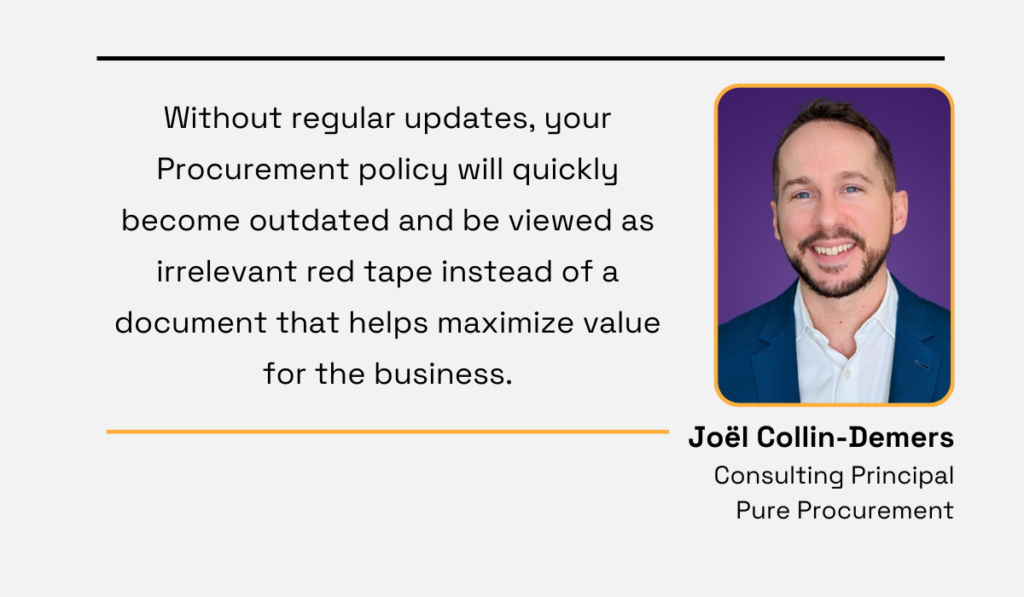
Illustration: Veridion / Quote: LinkedIn
They often fall short of meeting business needs, at least to the full extent, and end up being irrelevant at best, or slowing you down at worst.
That’s why staying on top of all relevant changes, learning from past audits, and incorporating these insights into your protocols and procedures are crucial steps toward ensuring the effectiveness and compliance of the procurement function.
You should know, however, that your biggest challenge won’t be drafting the policy itself, but getting all the stakeholders to actually accept and adhere to it.
According to James Meads, a digital procurement advisor and founder of Procurement Software, this has a lot to do with how you design your policies.
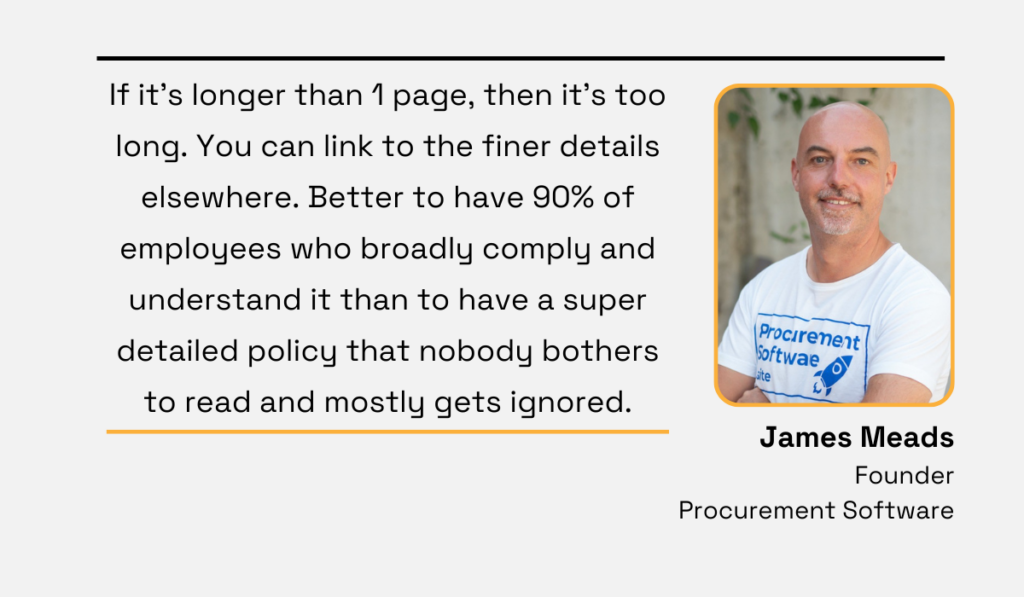
Illustration: Veridion / Quote: LinkedIn
He advocates for keeping them short, concise, and easy to understand.
Lengthy documents tend to be ignored, so brevity is key.
And, as Meads says, if you need some outside help, such as that of professional copywriters, don’t hesitate to ask for it.
Remember, the main goal here is implementation and enforcement, not just documentation.
The bottom line is this: the world of procurement is ever-changing, so you can’t be stuck in your old ways forever.
If you are, it won’t just reflect poorly on your auditing process, but on the success and reputation of the company as well.
So don’t be afraid of the updates, but embrace them and consider them an opportunity to take all your processes to a whole new level.
By now, you’ve probably sensed that the success of audits, whether they’re conducted internally or externally, is all about being proactive.
Think of it like this: if you’re quick to spot risks, adept at solving problems, keep everyone in the loop through frequent communication, and have robust procedures for documentation and evaluation in place, you’re already halfway there.
And remember, audits serve as a reflection of your procurement function’s effectiveness.
They’re not intended as attacks or critiques, but rather as guides highlighting areas for improvement.
So, consider following the tips we’ve just shared.
By doing so, you’ll start to see your audits not as necessary evil, but as catalysts for better results and smoother procurement processes all around.